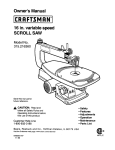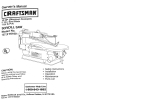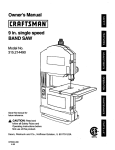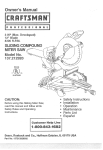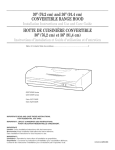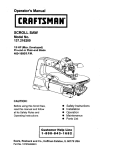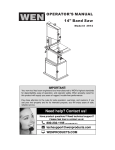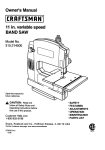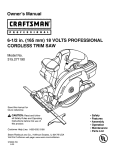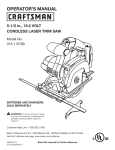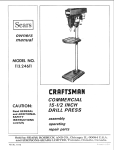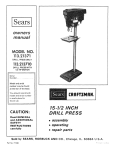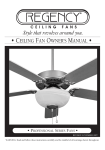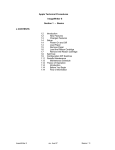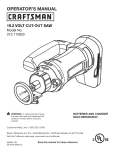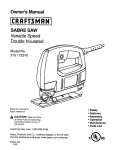Download Craftsman 315.216260 Owner`s manual
Transcript
Owner's Manual II:RRFTSMRNI 16 in, variable speed SCROLL SAW Model No. 315.216260 Save this manual for future reference. CAUTION: Read and follow all Safety Rules and Operating Instructionsbefore first use of this product. Customer Help Line 1-800-932-3188 • • • • • • Safety Features Adjustments Operation Maintenance Parts List Sears, Roebuck and Co., Hoffman Estates, IL 60179 USA VisLt the Craftsman web page: www.sears,com/craftsrnan 97200O-549 7-98 ® NRTL/C • Table of Contents ........................................................................................................................................... 2 • Warranty and Introduction.............................................................................................................................. 2 • Rules For Safe Operation ......................................................................................................................... • Electrical .......................................................................................................................................................... 6 • Glossary and Product Specifications ............................................................................................................. 7 • Unpacking and Tools Needed ........................................................................................................................ 8 • Labels ............................................................................................................................................................. 9 • Features .................................................................................................................................................. 10-11 • Assembly ................................................................................................................................................. 11-12 • Adjustments ............................................................................................................................................. 12-15 • Operation ................................................................................................................................................. 16-19 • Maintenance ............................................................................................................................................ 19-20 • Troubleshooting............................................................................................................................................ • Exploded View and Repair Parts List ...................................................................................................... 3-5 20 22-25 f • Parts Ordering / Service ............................................................................................................................... 26 FULL ONE YEAR WARRANTY ON CRAFTSMAN SCROLL SAW If this rRRFTSMRN" Scroll Saw fails due to a defect in material or workmanship within one year from the date of purchase, Sears will repair it, free of charge. Contact a Sears Service Center for repair. If this product is used for commercial or rental purposes, this warranty applies only for 90 days from the date of purchase. This warranty gives you specific legal rights, and you may also have other rights which vary from state to state. Sears, Roebuck and Co., Dept. 817WA, Hoffman Estates, IL 60179 Your saw has many features for making cutting operations more pleasant and enjoyable. Safety, performance and dependability have been given top priority in the design of this saw making it easy to maintain and operate. _. _IL _I, Look for this symbol to point out important safety is involved. safety CAUTION: Carefully read through this entire owner's manual before using your new saw. Pay close attention to the Rules For Safe Operation, and all Safety Alert Symbols including Danger, Warning and Caution. If you use your saw properly and only for what it is intended, you will enjoy years of safe, reliable service. precautions. It means attention!H Your WARNING: The operation of any power tool can result in foreign objects being thrown into your eyes, which can result in severe eye damage. Before beginning power tool operation, always wear safety goggles or safety glasses with side shields and a full face shield when needed. We recommend Wide Vision Safety Mask for use over eyeglasses or standard safety glasses with side shields, available at Sears Retail Stores. 2 Thepurposeof safetysymbolsIs to attract your attention to possible dangers. The safety symbols, and the explanations with them, deserve your careful attention and understanding. The safety warnings do not by themselves eliminate any danger. The instructions or warnings they give are not substitutes for proper accident prevention measures. SYMBOL MEANING A SAFETY ALERT SYMBOL: Indicates danger, warning or caution. May be used in conjunctionwith other symbols or pictographs. A DANGER: Failure to obey a safety waming will result in serious injury to yourself or to others. Always follow the safety precautions to reduce the risk of fire, electric shock and personal injury. ,a, WARNING: Failure to obey a safety warning can result in serious injuryto yourself or to others. Always follow the safety precautionsto reduce the risk of fire, electric shock and personal injury. & CAUTION: Failure to obey a safety warning may result in property damage or personal injuryto yourself or to others. Always follow the safety precautions to reduce the risk of fire, electric shock and personal injury. Note: Advises you of information or instructionsvital to the operation or maintenance of the equipment. r IMPORTANT Servicing requires extreme care and knowledge of the system and should be performed only by a qualified service technician. For service we suggest you return the tool to your nearest Sears store for repair. Always use original factory replacement parts when servicing. _lb ,_ • • • • WARNING: Do not connect your scroll saw to a power source until you have assembled and adjusted the saw as described in this manual and have read and understood all precautions and operating instructionsin the manual and printed on the tool. READ • • WARNING: Do not attempt to operate this tool until you have read thoroughly and understand completely all instructions, safety rules, etc. contained in this manual. Failure to comply can result in accidents involvingfire, electric shock, or serious personal injury. Save 6wner's manual and review frequently for continuing safe operation, and instructingothers who may use this tool. • ALL INSTRUCTIONS • KNOW YOUR POWER TOOL. Read the owner's manual carefully. Learn the saw's applications and limitations as well as the specific potential hazards related to this tool. • GUARD AGAINST ELECTRICAL SHOCK BY PREVENTING BODY CONTACT WITH GROUNDED SURFACES. For example; pipes, radiators, ranges, refrigerator enclosures. • KEEP GUARDS IN PLACE and in good working order. 3 REMOVE ADJUSTING KEYS AND WRENCHES. Get in the habit of checking to see that hex keys and adjusting wrenches are removed from tool before turning on the saw. KEEP THE WORK AREA CLEAN. Cluttered work areas and work benches invite accidents. DO NOT leave tools or pieces of wood on the saw while it is in operation. DO NOT USE IN DANGEROUS ENVIRONMENTS. Do not use power tools near gasoline or other flammable liquids, in damp or wet locations, or expose them to rain. Keep the work area well lit. KEEP CHILDREN AND VISITORS AWAY. All visitors should wear safety glasses and be kept s safe distance from work area. Do not let visitors contact tool or extension cord while operating. MAKE WORKSHOP CHILD-PROOF with padlocks and master switches or by removing starter keys, DO NOT FORCE THE TOOL. It will do the job better and safer at the rate for which it was designed. USE THE RIGHT TOOL. Do not force the tool or attachment to do a job it was not designed for. Don't use it for a purpose not intended, RULES m FOR SAFE OPERATION (Continued) U_E THE PROPER EXTENSION CORD. Make will operate properly and perform its intended function. Check for alignment of moving parts, bindingof moving parts, breakage of parts, saw stability,mounting and any other conditions that may affect its operation. A guard or other part that is damaged must be properly repaired or replaced by a qualified service technician at a Sears store to avoid risk of personal injury. sure your extension cord is in good condition. When using an extension cord, be sure to use one heavy enough to carry the current your product will draw. An undersized cord will cause a drop in line voltage resulting in'loss of power and overheating. A wire gage size (A.W.G.) of at least 18 is recommended for an extension cord 25 feet or less in length. If in doubt, use the next heavier gage. The smaller the gage number, the heavier the cord. DIRECTION OF FEED. Feed work into a blade or cutter against the direction of rotation of the blade or cutter only. INSPECT EXTENSION CORDS PERIODICALLY and replace if damaged. DRESS PROPERLY. Do not wear loose clothing, gloves, neckties, rings, bracelets, or other jewelry. They can get caught and draw you into moving parts. Rubber gloves and nonslip footwear are recommended. Also wear protective hair covering to contain long hair. NEVER LEAVE TOOL RUNNING UNATTENDED. TURN THE POWER OFF. Do not leave tool until it comes to a complete stop. m ALWAYS WEAR SAFETY GLASSES WITH SIDE SHIELDS. Everyday eyeglasses have only impact-resistant lenses; they are NOT safety glasses. TO PROTECT THE OPERATOR and minimize blade breakage, ALWAYS adjust the hold down foot to just clear the workpiece. Never operate the saw with any guard or cover removed. Make sure all guards are operating properly before each use. PROTECT YOUR LUNGS. Wear a face or dust mask if the cutting operation is dusty. PROTECT YOUR HEARING. Wear hearing protection during extended periods of operation. m SECURE WORK. Use clamps or a vise to hold work when practical. It's safer than using your hand and it frees both hands to operate tool. • DO NOT OVERREACH. Keep proper footing and balance at all times. MAINTAIN TOOLS WITH CARE. Keep tools sharp and clean for better and safer performance. Follow instructionsfor lubricating and changing accessories. DISCONNECT ALL TOOLS. When not in use, before servicing, or when changing attachments, blades, bits, cutters, etc., all tools should be disconnected from power supply. KEEP HANDS AWAY FROM CUTTING AREA. Do not hand hold pieces so small that your fingers go under the blade guard. Never reach underneath work or behind, under, or within three inches of the blade and its cutting path with your hands and fingers for any reason. Do not attempt to remove cut material when blade is moving. ,_k WARNING: • AVOID PINCHING THE BLADE. Be cautious when cutting off material which is irregular in cross section. For example, molding must lay flat on the table and not be permitted to rock. • DO NOT ABUSE CORD. Never yank cord to disconnect it from receptacle. Keep cord from heat, oil, and sharp edges. • INSPECT TOOL CORDS PERIODICALLY and if damaged, have repaired by a qualified service technician at a Sears store. Stay constantly aware of cord location and keep it well away from the rotating blade. • DO NOT USE TOOL IF SWITCH DOES NOT TURN IT ON AND OFF. Have defective switches replaced by a qualified service technician at a Sears store. AVOID ACCIDENTAL STARTING. Be sure switch is off when plugging in. USE RECOMMENDED ACCESSORIES. The use of improper accessories may cause risk of injury. NEVER STAND ON TOOL. Serious injury could occur if the tool is tipped or if the blade is unintentionally contacted. CHECK DAMAGED PARTS. Before further use of the tool, a guard or other part that is damaged should be carefully checked to determine that it USE ONLY CORRECT BLADES. Use the right blade size, style and cutting speed for the material and the type of cut. Blade teeth should point down toward the table. Sharp blades minimize stalling and kickback. Correctly adjust blade tension. Blades coast after turn off. RULES FOR SAFE OPERATION (Continued) KEEP TOOL DRY, CLEAN, AND FREE FROM OIL AND GREASE. Always use a clean cloth when cleaning. Never use brake fluids, gasoline, petroleum-based products, or any solvents to clean tool • POSITIONS where a sudden slip could cause your hand to move into the blade. ALWAYS make sure you have good balance. Do not cut pieces of material that are too small to hold comfortably in your hand. A LARGE PIECE OF MATERIAL SHOULD BE SUPPORTED while cutting. To minimize risk of blade pinching and kickback, always support long workpieces. Saw may slip, walk or slide while cutting long or heavy boards. • BEFORE MAKING A CUT, BE SURE ALL ADJUSTMENTS ARE SECURE. DO NOT FEED THE MATERIAL TOO QUICKLY while cutting. Do not force the workpiece against the blade. • NEVER CUT MORE THAN ONE WORKPIECE AT A TIME. If making a stacked cut, all of the pieces must be secured to each other with masking tape or double stick tape to make one workpiece. Do not put more than one workpiece on the saw table at a time. Always hold the work firmly against the table. See page 18. • AVOID CU'I-FING NAILS. Inspect for and remove all nails from lumber before cutting. • NEVER PERFORM LAYOUT, ASSEMBLY, OR SETUP WORK ON THE TABLE while the cutting tool is operating. • NEVER TOUCH BLADE or other moving parts during use, • NEVER START A TOOL WHEN THE BLADE IS IN CONTACT WITH THE WORKPIECE. Clear the table of debris before turning your scroll saw REPLACEMENT PARTS. All repairs, whether electrical or mechanical, should be made by qualified service technician at a Sears store or repair center. _1= WARNING: When servicing use only identical Craftsman replacement parts. Use of any other parts may create a hazard or cause product damage. BEFORE CHANGING THE SETUP, REMOVING COVERS, GUARDS OR BLADE, UNPLUG THE SAW, AND REMOVE THE SWITCH KEY. • AVOID AWKWARD OPERATIONS A_D HAND • NEVER USE IN AN EXPLOSIVE ATMOSPHERE. Normal sparking of the motor could ignite fumes. • DO NOT OPERATE THIS TOOL WHILE UNDER THE INFLUENCE OF DRUGS, ALCOHOL, OR ANY MEDICATION. STAY ALERT AND EXERCISE CONTROL. Watch what you are doing and use common sense. Do not operate tool when you are tired. Do not rush. on, ALLOW THE MOTOR TO COME UP TO FULL SPEED before starting a cut. • MAKE SURE THE WORK AREA HAS AMPLE LIGHTING to see the work and that no obstructions will interfere with safe operation BEFORE performing any work using your saw. • ALWAYS TURN OFF SAW before disconnecting it, to avoid accidental starting when reconnecting to power supply. NEVER leave the scroll saw unattended while connected to a power source. _. WARNING: Do not allow familiarity with your saw make you careless. Remember that a careless fraction of a second is sufficient to inflict severe injury. SAVE THESE INSTRUCTIONS. Refer to them frequently and use to instruct other users. If you loan someone this tool, loan them these instructions also. FIRMLY CLAMP OR BOLT your scroll saw to a firm, level workbench or table. The most comfortable saw table height is at approximately hip height. SAVE THESE INSTRUCTIONS 5 EXTENSION CORDS ELECTRICAL Use only 3-wire extension cords that have 3-prong grounding plugs and 3-pole receptacles that accept the tool's plug. When using a power tool at a considerable distance from the power source, use an extension cord heavy enough to carry the current that the tool will draw. An undersized extension cord will cause a drop in line voltage, resulting in a loss of power and causing the motor to overheat. Use the chart provided below to determine the minimum wire size required in an extension cord. Only round jacketed cords listed by Underwriter's Laboratories (UL) should be used. Length of Extension Cord Up to 25 feet 26-100 feet Your Sears Craftsman Scroll Saw is powered by a precision built electric motor. It should be connected to a power supply that Is 120 volts, 60 Hz, AC only (normal household current). Do not operate this tool on direct current (DC). A substantial voltage drop will cause a loss of power and the motor will overheat. If the saw does not operate when plugged into an outlet, double check the power supply. GROUNDING INSTRUCTIONS In the event of a malfunction or breakdown, grounding provides a path of least resistance for electric current to reduce the risk of electric shock. This tool is Wire Size (A.W.G.) 18 equipped with an electric cord having an equipmentgrounding conductor and a grounding plug. The plug must be plugged into a matching outlet that is propedy installed and grounded in accordance with all local codes and ordinances. 16 When working with the tool outdoors, use an extension cord that is designed for outside use. This is indicated by the letters WA on the cord's jacket. Do not modify the plug provided. If it will not fit the outlet, have the proper outlet installed by a qualified electrician. Improper connection of the equipmentgrounding conductor can result in a risk of electric shock. The conductor with insulation having an outer surface that is green with or without yellow stripes is the equipment-grounding conductor. If repair or replacement of the electric cord or plug is necessary, do not connect the equipment-grounding conductor to a live terminal. Before using an extension cord, inspect it for loose or exposed wires and cut or worn insulation. _i, CONNECTION CAUTION: Keep the cord away from the cutting area and position the cord so that it will not be caught on lumber, tools, or other objects during cutting. Check with a qualified electrician or service personnel if the grounding instructions are not completely understood, or if in doubt as to whether the tool is properly grounded. Repair"or replace a damaged or worn cord immediately. "This tool is intended for use on a circuit that has an outlet like the one shown in Figure 1. It also has a grounding pin like the one shown. GROUNDING PIN COVEROF GROUNDED OUTLETBOX Fig. 1 6 Bevel Cut A cutting operation made with the table at any angle other than 90" to the blade. Crosscut A cutting or shaping operation made across the grain of the workpiece. Compound Cut A compound cut is a cut made using a miter angle and a bevel angle at the same time. Resin A sticky, sap base substance that has hardened. Ripping A cutting operation along the length of the workpiece. Saw Blade Path The area directly in line -- over, under, behind, or in front of the blade. AS it applies to the workpiece, that area which will be, or has been, cut by the blade. Set The distance that the tip of the saw blade tooth is bent (or set) outward from the face of the blade. Freehand (for scroll saw) Performing a cut without the workpiece properly supported on the table. SPM Strokes per minute. Used in reference to blade movement. Gum A sticky, sap based residue from wood products. Kerr The matedal removed by the blade in a through cut or the slot produced by the blade in a nonthrough or partial cut. Leading End The end of the workpiece pushed into the cutting tool fimt. Throw-Back Throwing of a workpiece in a manner similar to a kickback. Usually associated with a cause other than the kerr closing, such as a workpiece not being against the fence, being dropped into the blade, or being placed inadvertently in contact with the blade. Through Sawing Any cutting operation where the blade extends completely through the thickness of the workpiece. Miter Cut A cutting operation made with the saw table at an_ angle other than 90" to the blade. Workpiece The item on which the cutting operation is being done. The surfaces of a workpiece are commonly referred to as faces, ends, and edges. Nonferrous Metal Metal that does not contain iron; such as aluminum, brass, and copper. Worktable The surface on which the workpiece rests while performing a cutting or sanding operation. Push Stick A device used to feed the workpiece through the saw blade during narrow ripping type operations and helps keep the operator's hands well away from the blade. Resaw A cutting operation to reduce the thickness of the workpiece to make thinner pieces. Throat Table Tilt 16 in. Motor 120 V, 1.2 amp 60 HZ-AC only Drive Variable Speed Overall Dimensions 500-1700 Strokes per minute Blade Length Table Size Net Weight 5 in. plain or pin 10-1/4 in. x 12 in. 7 47" right and 12" left 12in. W 24-1/2 in. L 14in. H 27.5 lb. ,_ WARNING: To prevent accidental starting or electrical shock that could cause possible serious personal injury, assemble all parts to your saw before connecting it to power supply. Saw should never be connected to power supply when you are assembling parts, making adjustments, lubricating, installingor removing blades, cleaning, or when not in use. Carefully lift saw from the carton and place it on a level work surface. • Do not discard the packing materials until you have carefully inspected the saw, identified all pads, and satisfactorily operated your new saw. Note: If any parts are damaged or missing, do not attempt to plug in the power cord and turn the switch on until the damaged or missing parts are obtained and are installed correctly. Your scroll saw comes completely assembled. A package of 4 extra blades and an owner's manual are included with your saw. Remove pack of 4 extra blades and owner's manual from the carton. _, WARNING: If any parts are missing, do not operate this tool until the missing parts are replaced. Failure to do so could result in possible serious personal injury. The following tools (not included) are needed for adjustments and alignment: • Small Combination Square • Adjustable wrench • Flatblade Screwdriver SMALL COMBINA_ON SQUARE FLATBLADESCREWDRIVER Fig. 2 The following labels are on the scroll saw with locations indicated. WARNING ADVERTENCIA ON OFF I I:RRFTSMAN1 Customer Help Line 1-800-932-3188 WARNING I ADVERTENCIA Fig. 3 Thisversatilevariablespeedscrollsawis greatfor making toys, puzzles, games, artwork, and jewelry. It is a handy do-it-yourself tool. It cuts wood, wood composition products, plastic, and other fibrous material up to 2 inches thick. It also cuts nonferrous metals (aluminum, brass, copper). KNOW YOUR SCROLL SAW Before attempting to use your saw, familiarize yourself with all operating features and safety requirements of your Sears Craftsman scroll saw. See Figure 5. BLADE DRAWER ON/OFF KNOB WITH VARIABLE SPEED Your scroll saw has an easy access ON/OFF knob with variable speed. Pull the knob out to turn ON the saw, and push the knob in to turn OFF the saw. Turn the knob to adjust the speed from the high speed of approximately 1700 SPM (Strokes Per Minute) to the low speed of approximately 500 SPM. LOCK Fig. 4 BLADE STORAGE DRAWER Attached under the left side of the table is a blade storage drawer. It will hold up to 20 blades. Drawer snaps closed securely. See Figure 4. OFF POST Place a pad lock in the lock post next to the ON/OFF knob to look the saw in the OFF position to prevent , unauthorized use of the saw by children or others. BLADE TENSION KNOBS Blade tension is controlled by a dual knob tension control system. The inner (smaller) knob, tension adjusting knob, is for making adjustments of the blade tension. The outer (larger) knob, quick release knob, is used to quickly set and release blade tension to facilitate blade changes, TOOLLESS BLADE HOLDERS Retain and position the blade without the use of additional tools. Use the knobs for plain end blades or use the designed slots for pin type blades. TENSION ADJUSTING KNOB QUICKRELEASE KNOB AIRDIAPHRAGM HOLDDOWNFOOTLOCKKNOB PLAINENDBLADEKNOB HOLDDOWNFOOT/ GUARD SAWBLADE SAWTABLE MITERSCALE BEVELADJUSTMENTKNOB MOTOR LOCKOFF POS'I' ON/OFFKNOB Fig. 5 10 HOLD DOWN FOOT/BLADE GUARD The hold down foot should be lowered until it just rests on top of the workpiece to prevent the workpiece from lifting while cutting, but not so much that the workpiece drags. The vertical portion provides a blade guard to prevent accidental blade contact. HOLD DOWN FOOT LOCK KNOB Allows you to raise or lower the hold down foot/blade guard and secure it at desired heights• SAWDUST BLOWER Keeps the line of cut on workpiece clean for more accurate scroll cuts. SAWDUST EXHAUST Your saw has a sawdust exhaust that fits a standard shop vacuum hose. See Figure 13. SAW TABLE Your scroll saw has an aluminum saw table that provides a working surface to support your workpiece. TABLE ZERO DEGREE STOP FOR TABLE Located under the front of the saw table, the zero degree stop allows easy return and fine adjustment of the zero degree relationship between the table and the blade. • SAW • diameterholesthrough work- Insert all three 3/8 in. bolts and tighten securely with lock washers and hex nuts. Note: All bolts should be inserted from the top. Install the lock washers and hex nuts from the underside of the bench. TO Supporting surface where scroll saw is mounted should be examined carefully after mounting to insure that no movement during use can result. If any tipping or walking is noted, secure workbench or supporting surface before beginning cutting operations. If the scroll saw is to be used in a permanent application, we recommend that you secure it in a permanent location such as a workbench. When mounting the saw to a workbench, holes should be drilled through the supporting surface of the workbench using dimensions illustrated. • Drill(3)7/16in. bench. Place scroll saw on workbench aligning holes in the base with holes drilled in the workbench. WARNING: To avoid serious personal injury from unexpected tool movement, always securely mount scroll saw to a workbench. MOUNTING SCROLL WORKBENCH See Figure 6. KNOB BEVEL SCALE The bevel scale and indicator are located on the front of the saw for easy viewing. They show the angle of the table• Your Craftsman 16 in. scroll saw was fully assembled at the factory. Before operating this tool, it is important to check all alignments and settings. Normal handling during shipment may have changed settings. _L LOCK Allows you to tilt the table and lock it at the desired angle up to 45 degrees. 24 in. II Each hole in the base of the saw should be bolted securely using 3/8 in. diameter machine bolts, lock washers, and hex nuts (not included). Bolt length should be 1-1/4 in. plus the thickness of the bench top. Locate and mark the holes where scroll saw is to 7/16In. dia. € T' 12 In. 6 In. be mounted. .I 19 1116 In. Fig. 6 11 CLAMPING SCROLLSAW WORKBENCH TO See Figure 7. tf the scroll saw is to be used in a portable application, we recommend that you fasten it permanently to a mounting beard that can easily be clamped to a workbench or other supporting surface. The mounting board should be of sufficient size to avoid tipping of saw while in use. Mount saw to board using holes in frame as a template for hole pattern or the diagram in Figure 6. Locate and mark the holes where scroll saw is to be mounted. • \ Follow last three steps in previous section called • ounUng Scroll Saw to Workbench. C-CLAMP Make sure mounting bolts are long enough to go through holes in the saw frame, material being mounted to, lock washers, and hex nuts. MOUNTING BOARD Note: It may be necessary to countersink hex nuts and washers on bettom side of mounting board. C-CLAMP WORKBENCH ,_k AIRDIAPHRAGM WARNING: To prevent accidental starting that could cause possible serious personal injury, turn off the sew and unplug before making any adjustments. HOLD DOWN See Figure 8. FOOT/BLADE Fig. 7 HOLDDOWNFOOT KNOB GUARD BLADE The hold down should be adjusted so it contacts the top surface of the work being cut. Tighten adjusting knob after adjustment has been made. • Loosen the hold down foot lock knob. • Move the hold down foot to the desired position. • Tighten the hold down foot lock knob. The tall, front part of the hold down foot acts as a blade guard to prevent accidental contact with the blade. SAWDUST BLOWER Fig. 8 See Figure 8. The dust blower is designed and preset to direct air to the most effective point on the cutting line. Be sure hold down foot is properly adjusted to properly secure workpiece and to properly direct air to the cutting surface. • Insert hose to air diaphragm before starting the saw. 12 SQUARING TABLE TO THE SETTING THE TABLE FOR OR BEVEL CUTTING See Figures 10, 11 and 12. BLADE See Figures 9 and 10. • Loosen the hold down foot lock knob and move hold down rod all the way up. Tighten knob. • Loosen the table lock knob and move the table until it is approximately perpendicular, or st right angle to the blade. • • HORIZONTAL A bevel scale is provided under the work table as a convenient guide for setting the approximate table angle for bevel cutting. When greater precision is required, make practice cuts on scrap material and adjust the table as necessary for your requirements. An adjustable zero degree stop is provided to quickly return the table to the zero degree setting. Place a small square on the table next to the blade to check if the table is 90 degrees to the blade. If adjustment is needed, raise or lower the table until table is approximately 90 degrees to the blade and securely tighten the table lock knob. • Loosen the screw holding the scale indicator, move indicator to the 0 degree mark and securely tighten screw. Remember, the bevel scale is a convenient guide but should not be relied upon for precision. Make practice cuts on scrap material to determine if your angle settings are correct. Loosen the table lock knob and push down on the right side of the table. If the table stops at O', the zero degree stop is properly set. If the table stops somewhere other than zero, then adjust the zero degree stop. ZERO DEGREE II I i • Adjust the hold down foot to desired position and securely tighten the hold down foot knob. HOLDDOWNROD HOLDDOWNFOOT LOCKKNOB "__ HOLDDOWN F00T/ . SAWBLADE TABLELOCK KNOB • \ SCALE SCREW Fig. 10 To access the zero degree stop, loosen the table look knob, and tilt the table with the dght side all the way down. Just under the front of the saw table is the zero degree stop. See Figure 11. Loosen the hex nut and rotate the hex bolt to raise or lower the bolt as needed to adjust the zero degree stop. Be sure to check to see that the table is square to the blade. Now, by returningthe table to the zero position, the zero degree stop provides a quick reference to the preset position. TABLELOCK KNOB Fig. 9 13 HEXBOLT SAWTABLE HEXNUT • On the top back of the saw, rotate the quick release knob to the left or counterclockwise to loosen blade tension. See Figure 5. • Remove the throat plate. • Place blade through the throat plate opening with the teeth of the blade to the front of the saw and pointing down toward the table. Engage the pin into the "V" notch of the lower blade holder. • ZERO DEGREE STOP ASSEMBLY Pull up on the blade and push down on the saw arm to engage the upper pin in the "V" notch of the upper blade holder. Note: If the blade touches the hold down foot on either side then the hold down foot must be adjusted. Fig.11 • • The zero stop assembly can be rotated to the left and down out of the way and the table can be angled up to 12" to the left. See Figure 12. Loosen the foot adjusting knob. See Figure 13. To center the hold down foot around the saw blade, slide the hold down foot to the side. • Tighten the foot adjusting knob. • To tension the blade, rotate the quick release knob (outer, larger knob) 114 turn to the right or clockwise to apply tension to the blade. Fine adjustments of the blade tension may be performed using the tension adjusting knob (inner, smaller knob) at any time, while the blade is under tension or not. Note: Make sure the zero degree stop is rotated all the way down or it will contact the blade storage drawer as you angle to the left. • Replace throat plate. Plain End •lades See Figure 13. Fig. 12 INSTALLING BLADES Scroll saw blades wear out quickly and must be replaced frequently for best cutting results. Expect to break some blades while you learn to use and adjust your saw. Blades generally stay sharp for 1/2 hour to 2 hours of cutting, depending on type of material and speed of operation. Turn off and unplug the saw from outlet. ,_ WARNING: To avoid injury from accidental starting, always turn off and unplug the saw before installing, removing or replacing the blade. Turn off and unplug the saw from outlet. A WARNING: To avoid injury from accidental starting, always turn off and unplug the saw before installing, removing, or replacing the blade. • On the top back of the saw, rotate the quick release knob to the left or counterclockwise to loosen the blade tension.See Figure 5. • Remove the throat plate. • Loosen the blade knobs by hand and remove the blade. Place new blade through the throat plate opening in the table with the teeth of the blade to the front of the saw and pointing down toward the table. Next, place blade in the lower blade holder into the slot that enlarges as you loosen the blade knob. Pin End Blades See Figure 13. • • Position blade and securely tighten blade knob. Pull up on the blade and down on the saw's upper arm to install blade into upper blade holder. Note: If the blade touches the hold down foot on either side then the hold down foot must be adjusted. 14 • Loosen the foot adjusting knob. See Figure 13. • To center the hold down foot around the saw blade, slide the hold down foot to the side. • Tighten the foot adjusting knob. • Position blade and securely tighten blade knob. • Turn the quick release knob to the right or clockwise to tension the blade. • Turn the tension adjusting knob to the right, clockwise or to the left, counterclockwise until the blade is in desired tension. • TO RELEASE QUICKRELEASE KNOB Fig. 14 Turn tension adjusting knob (upper, smaller knob) to the right or clockwise to increase tension. Turn it to the left or counterclockwise to decrease blade tension. Replace throat plate. PLAIN ENDBLADE PLAIN END BLADEKNOB TO ENGAGE FOOTADJUSTING Note: Adjustments of blade tension can be made at anytime. The quick release knob can be either released or engaged while making adjustments with the tension adjusting knob. TENSIONADJUSTINGKNOB TO INCREASE TENSION HOLDDOWNFOOT PIN END BLADE PLAINEND BLADEKNOB Fig. 15 • © SAWDUST EXHAUST Rotate quick release knob to the right or clockwise 1/4 turn to engage tension before using the scroll saw. Check tension by the sound the blade makes when plucked like a guitar string. This method of adding tension to the blade can be developed with practice and requires knowing your scroll saw. Fig. 13 ADJUSTING TO DECREASE TENSION BLADE TENSION See Figures 14 and 15. • Turn off and unplug the saw. ,_k WARNING: Failure to unplug your saw could result in accidental starting causing possible serious personal injury. Tension adjusting knob is on the top of the saw. See Figure 5. Rotate the quick release knob (outer, larger knob) 1/4 turn to the left or counterclockwise to release blade tension. • Pluck the back straight edge of blade while turning tension adjusting knob. Sound should be a musical note. Sound becomes less flat as tension increases. Sound decreases with too much tension. Note: Be careful not to over tension the blade. Too much tension may cause blade to break as soon as you start cutting. Too little tension may cause blade to bend or break before teeth wear out. Thisscrollsawis designed tocutwood,woodcompositionproducts,plastic,andnonferrous metals(aluminum,brass,copper). GENERAL OPERATION Please read and understand the following items concerning your scroll sew before attempting to use the sew. • There is a learning curve for each person who wants to use this sew. Dudng that pedod of time it is expected that some blades will break until you learn how to use and adjust the sew. • Allow the saw to cut material by guiding the workpiece into the blade as it moves. Do not force the work. • The blade teeth cut matedal only on the down stroke. ON/OFF KNOB WITH VARIABLE SPEED See Figure 16. Your scroll saw has an easy access On/Off knob with variable speed. • Pull the knob out to turn ON the saw, and push the knob in to turn OFF the sew. Note: After saw is turned on, a hesitation before blade movement is normal. WARNING: Never leave the saw unattended until the blade has come to a complete stop to prevent serious personal injury. You must guide the workpiece into the blade slowly because the teeth of the blade are very small and can only remove matedal on the down stroke. • • Scroll saw blades wear out and must be replaced frequently for best cutting results. Scroll saw blades generally stay sharp for 112 hour to 2 hours of cutting, depending on type of material and speed of operation. To get accurate cuts, be prepared to compensate for the blade's tendency to follow the wood grain as you are cutting wood. • In cutting wood, best results are achieved when cutting wood less than one inch thick. • When cutting wood thicker than one inch, the user must guide the workpiece very slowly into the blade and take extra care not to bend or twist the blade while cutting. • When choosing a blade to use with your scroll sew, consider the following carefully: POST ON/OFFKNOB • • Very fine, narrow blades should be used to scroll cut in thin matedal 1/4 in. thick or less. By turning the knob, the variable speed control may be adjusted from the high speed of approximately 1700 SPM (Strokes Per Minute) to the low speed of approximately 500 SPM. Suggested speeds are identified under Choice of Blade and Speed, page 18. Turn the On/Off knob to the right or clockwise to increase strokes per minute and to the left or counterclockwiseto reduce the strokes per minute. This motor has an electronic control that regulates the speed and provides ovedoad protection to the motor. If the motor fails to start after about 2 seconds, push the knob OFF and disconnect the saw from the power source. Refer to the troubleshooting chart. Note: I1the internal overload protector has been tripped, pushing the On/Off knob OFF will reset it. Most blade packages state the size or thickness and type of material which that blade is intended to cut. Package should also state the radius, or size of curve, which can be cut with that blade. • Wider blades cannot cut curves as tight or small as thinner blades. • Fig. 16 Blades wear faster: • When cutting plywood and other laminates. • When cutting matedal thicker than 3/4 in. • When cutting hardwood. • When side pressure is applied to the blade. 16 LOCK INTERIOR POST See Figure 17. To prevent unauthorized use of your scroll saw, we suggest that you disconnect it from the power supply and lock the knob in the OFF position. A padlock with a shackle of 5 mm or 3/16 in. diameter should be used. When the lock is installed and locked, as illustrated, the switch is inoperable. Store the padlock key in another location. • ,_ To lock the saw in the OFF position, install a padlock through the lock post beside the knob as illustrated and lock the padlock. (Padlock is not supplied with the saw.) WARNING: For your own safety, always push the knob OFF when machine is not in use. Also, in the event of a power failure, push knob OFF. Lock the scroll saw switch OFF with a padlock. This will prevent the machine from starting up again when the power comes back on. Failure to heed this warning can result in serious personal injury. SCROLL CUTTING See Figure 18. • One of the features of a scroll saw is that it can be used to make scroll cuts on the interior of a board without breaking or cutting through the edge or perimeter of the board. & WARNING: To avoid possible serious injury from accidental starting, always turn the switch OFF and remove plug from power source outlet before removing or replacing the blade. • To make interior cuts in a board, remove the scroll saw blade as explained in the Installing Blades section on page 14. • Drill a 114in. hole in the board to be used to make interior cuts. • Place the board on the saw table with the hole in the board over the access hole in the table. • Install blade through hole in board then adjust the hold down foot and the blade tension. See pages 14 and 15. • When finished making the interior scroll cuts, simply remove the blade from the blade holders as described in the Installing Blades section, and remove the board from the table. DRILLHOLE INTERIOR PADLOCK ON/OFFKNOB Fig. 17 Fig. 18 17 STACK CUTTING See Figure 19. After becoming well acquainted with your saw through practice and experience, you may wish to try stack cutting. Stack cutting may be used when several identical shapes need to be cut. Several pieces of wood may be stacked on top and secured to each other before cutting. The wood pieces may be joined together by placing double sided tape between each piece or by wrapping masking tape around the comers or ends of the stacked wood. You must attach the stacked pieces of wood to each other so they will move on the table as a single piece of material. _k 0 WARNING: To avoid possible, serious personal injury, do not cut more than one loose piece of material at a time. Fig. 19 CHOICE OF BLADE AND SPEED The scroll saw accepts a wide variety of blade widths and thicknesses for cutting wood and other fibrous materials. Your saw uses 5 inch long blades of either the pin end or the plain end style. The blade width and thickness and the number of teeth per inch to use are determined by the type of material and the size of the radius being cut. A full selection of scroll saw blades ere available through Sears Retail Stores. Note: As a general rule, always select narrow blades for intricate curve cutting, and wide blades for straight and large curve cutting. Teeth/Inch Thickness 10 .110 in. .020 in. 1200-1700 15 .110 in. .020 in. 600-1200 Wood, plastics, extremely thin cuts on materials 3/32 in. to 1/2 in. thick. 18 .095 in. .010 in. 500-600 For tight radius work in thin materials 3/32 in. to 1/8 in. wood, veneer, bone, fiber, ivory, plastic, etc. BEFORE • • • Speed or Strokes Per Minute Width EACH USE: Material Cut Popular size for cutting hard and soft woods 3116 in. up to 2 in. Plastics, paper, felt, bone, etc, • Always use extra supports (tables, saw horses, blocks, etc.) for any workpiece large enough to tip when not held down to the table top. INSPECT YOUR SAW. Disconnect the saw. To avoid injury from accidental starting, turn the switch OFF and unplug the saw before changing the setup or removing covers, guards, or blade. INSPECT YOUR WORKPIECE. Make sure there are no nails or foreign objects in the workpiece to be cut. • Never use another person as a substitute for a table extension, or as additional support for a workpiece or to help feed, support, or pull the workpiece. • When cutting an irregularly shaped workpiece, plan your work so it will not pinch the blade. A piece of molding, for example, must lay flat or be held by a fixture or jig that will not let it twist, rock, or slip while being cut. USE EXTRA CAUTION WITH LARGE, VERY SMALL, OR AWKWARD WORKPIECES. • Never use this tool to cut pieces too small to hold by hand. 18 Properlysupportroundmaterialsuchasdowel rods.Theyhavea tendency torollduringa cut, causingthebladeto "bite." To avoid this, always WHEN BACKING OUT OF THE WORKPIECE, THE BLADE MAY BIND IN THE KERF (CUT). THIS IS USUALLY CAUSED BY SAWDUST CLOGGING UP THE KERF. IF THIS HAPPENS: use a "v" block. • Turn switch OFF, • Clear everything except the workpiece and related support devices off the table before plugging into power and turning the saw on. B PLAN THE WAY YOU WILL HOLD THE WORKPIECE FROM START TO FINISH. Do not hand hold pieces so small that your fingers will go under the work hold-down. • BEFORE FREEING ANY JAMMED MATERIAL: • Turn switch OFF. • Wait for all moving parts to stop. • Unplug the saw. • Remove the blade from the blade holders. • & • Wait for all moving parts to stop. • _. Remove the workpiece with blade from the table. • Remove blade from workpiece. WARNING: Before removing loose pieces from the table, turn saw off and wait for all moving parts to stop to avoid serious personal injury. Unplug the saw. WARNING: When servicing, use only identic&l Craftsman replacement parts. Use of any other part may create a hazard or cause product damage. BRONZEBEARING WARNING: To prevent accidental starting that could cause possible serious personal injury, turn off and unplug the saw before maintaining or lubricating your scroll saw. GENERAL MAINTENANCE Keep your Scroll Saw clean. After cleaning the table top initially,apply a thin coat of automobile type (paste) wax to the table top so the wood slides easily while cutting. ARM BEARINGS See Figure 20. Lubricate the arm bearings after every 50 hours of use or whenever there is a squeak coming from the bearings. • Carefully place the saw on its side as shown in Figure 20. Remove the rubber cap from the lower arm of the saw. • Squirt a few drops of SAE20 oil around the shaft end and bronze bearing. Let oil soak in overnight, remaining in this position. MOTOR BRUSHES See Figure 21. Your saw has externally accessible brush assemblies that should be checked periodically for wear. When one of the two brushes becomes worn, replace both brushes. Note: Lubricate the upper arm bearing from the other side of the saw. _k, WARNING: If the power cord is worn, cut, or damaged in any way, have it replaced immediately by a qualified service technician at a Sears store to avoid risk of personal injury. 19 • Unplug your saw. _, WARNING: Failure to unplug your saw could result in accidental starting causing serious injury. • Remove brush cap with a flat blade screwdriver. • Remove brush assembly. Gently pry the brush assembly out using a small screwdriver, point of a nail or paperclip, etc. Check for wear. If one brush is worn down shorter than 114 in., replace both brushes. Do not replace one side without replacing the other. • \ • Reassemble using new brush assembly. Make sure curvature of brush matches curvature of motor and that brush moves freely in brush tube. Use the blunt end of something thin (eraser end of pencil, etc.) to push the brush into the tube until it stays. • Make sure brush cap is oriented correctly (straight) and replace. • Tighten brush cap using a hand powered screwddver only. Do not overtighten. • Repeat for other brush. ,_ WARNING: For your own safety, turn switch OFF and remove plug from power outlet before adjusting or aligning your scroll saw. PROBLEM Motor will not run. _j_1. CAUSE SOLUTION 1. Problem with ON-OFF switch, power cord, or outlet. 2. Motor Defective. Blades breaking. Vibration (there is always some vibration when the saw is running). Blade runout (blade not properly aligned with arm motion). BRUSHCAP Fig. 21 I. Have worn parts replaced before using Scroll Sew again. Have the proper outlet installed by a qualified electrician. 2, Do not attempt any repair. Have repaired by a qualified service technician at a Sears store or repair center. 1. Too much tension. 1. Adjust tension. 2, Feeding too quickly. 2. Reduce feed rate. 3, Wrong blade. 3. Narrow blades for cutting thin wood or tight corners and turns, wide blades for thicker wood or wide turns, 4. Blade twisting in wood. 4. Reduce side pressure on blade, check blade tension. 1. Improper mounting of saw. 1. Check mounting. 2. Mounting surface. 2. Check mounting in manual. 3. Loose table or table resting against motor. 3. Tighten table lock knob. 4. Loose motor mounting. 4. Tighten mounting screws. 1. Blade holders out of line. 1.Realign blade. 20 21 CRAFTSMAN SCROLL SAW - MODEL NO. 315.216260 /-/ /*° / ./'/" /'/25 Po r_ 27 15 24 23 52 26 18 17 16 15 39 28 29 36 33 32 22 21 34 _-35 49 FIGURE A CRAFTSMAN SCROLL SAW - MODEL NO. 315.216260 PARTS LIST FOR FIGURE A Pert Number Description 1 979817-001 Blade Lock Knob........................................... 2 980119-001 Blade Holder ................................................. Key No. Part Number 1 27 979772-001 Indicator ........................................................ 1 1 28 979820-001 Hex Bolt ........................................................ 1 1 Description Quan. 3 979814-001 Spring Pin ..................................................... 1 29 979821-001 Hex Nut ......................................................... 4 979813-001 Spring Pin ..................................................... Saw Blade ..................................................... 1 1 30 979822-001 Hex Bolt (Socket Hd. Special) ...................... 1 31 979823-001 Washer ......................................................... 1 5 6 979832-001 Throat Plate .................................................. 1 32 979824-001 Stopper ......................................................... 1 7 979810-001 Table ............................................................. 1 33 979825-001 979771-001 Spring Pin ..................................................... Base .............................................................. 1 1 4 979809-001 Table Screw .................................................. 1 34 9 979807-001 Blade Drawer ................................................ 1 35 979769-001 Hex Bolt ........................................................ 10 979806-001 Blade Drawer Bracket ................................... 1 36 979768-001 Waming Label ............................................... 1 3 8 11 Po Co Key No. Ouan. 979729-001 Washer ......................................................... 3 37 979770-001 Hex Bolt ........................................................ 979766-001 Screw (Pan Hd.) ........................................... Nozzle ........................................................... 2 1 2 t 12 979730-001 Screw (Pan Hd.) ........................................... 3 38 13 979808-001 Screw (Pan Hd.) ........................................... 2 39 979767-001 14 979805-001 Bevel Lock Knob ........................................... 1 40 979801-001 979800-001 Screw (Pan Hd.) ........................................... Control Box ................................................... 15 979804-001 Flat Washer .................................................. 2 41 16 979803-001 Scale ............................................................. 1 42 979799-001 PC Board Assembly ..................................... t 17 979802-001 Miter Scale Bracket ...................................... 1 43 979798-001 Gasket .......................................................... 1 1 18 980123-001 Motor (Includes Kay Nos. 19, 20, 21, & 22). 1 44 979797-001 On/Off Knob .................................................. 19 979788-001 Clamp Screw ................................................ 2 45 979796-001 Knob Label .................................................... 1 20 979786-001 Brush Holder ................................................. 2 46 979794-001 Motor Pointer ................................................ t 21 979785-001 Brush Assembly ............................................ 2 47 979793-001 Switch Label ................................................. t 979795-001 Motor Cover .................................................. 1 22 979784-001 Brush Cap ..................................................... 2 48 23 979775-001 Counterbalance ............................................ 1 49 979790-001 Power Cord Assembly .................................. 1 24 979776-001 Clamp Screw ................................................ 1 50 979791-001 Strain Relief .................................................. 1 25 979774-001 Spacer .......................................................... 1 51 979789-001 Screw (Pan Hd.) ........................................... 4 1 52 979777-001 Motor Screw .................................................. 3 26 979773-001 Screw (Pan Hd.) ........................................... *** Available at your nearest Sears Retail Store. " CRAFTSMAN SCROLL SAW - MODEL NO. 315.216260 29 30 37 28 38 12 39 40 14 j:. 12 20 18 16 21 13 15 FIGURE B CRAFTSMAN I SCROLL SAW - MODEL NO. 315.216260 PARTS LIST FOR FIGURE Key No. 1 Po O1 I | The model number will be found on a plate attached to the frame. Always mention the model number in all correspondence regarding your SCROLL SAW or when ordering repair parts. Pad Number Description Quart. I A Key No. Pad Number Description 24 979758-001 Ball Beadng .................................................. 2 Quen. 979827-001 Tension AdjustingKnob ........................... ,... 1 2 979737-001 Spring Pin ..................................................... 1 25 979826-001 Bolt (Hex Hd.) ............................................... 1 3 979736-001 Quick Release Knob ..................................... 1 26 979752-001 Right Arm Cover ........................................... 1 4 979742-001 Rubber Boot.................................................. 1 27 979751-001 Spring Pin ..................................................... 1 5 979735-001 Cam .............................................................. 1 28 979740-001 Screw (Pan Hd.) ........................................... 8 6 979766-001 Arm Spdng .................................................... 1 29 979738-001 Data Plate ..................................................... 1 7 979734-001 Hold Down Foot Lock Knob .......................... 1 979828-001 1 1 979741-001 8 Tension Wedge ............................................. Washer ......................................................... 30 31 979831-001 Support Bar Assembly .................................. 1 Tension Bolt .................................................. 1 32 979744-001 Foot AdjustingKnob ..................................... 1 979745-001 9 979733-001 10 979830-001 E-Ring ........................................................... 1 33 Support Plate ................................................ 1 11 979732-001 Tension Wedge ............................................. 1 34 979749-001 Hold Down Clamp ......................................... 1 12 979765-001 Bushing......................................................... 4 35 979743-001 Washer/Spacer ............................................. 1 Lower Arm .................................................... 1 36 979747-001 Hold Down Foot ............................................ 1 979746-001 Air Hose ........................................................ 1 13 979763-001 14 979764-001 Spacer Bearing ............................................. 2 37 15 979814-001 Spring Pin ..................................................... 1 38 979748-001 Air Diaphragm ............................................... 1 16 979813-001 1 1 979753-001 Upper Arm .................................................... 1 980119-001 Spring Pin ..................................................... Blade Holder ................................................. 39 17 40 979754-001 18 979817-001 Blade Lock Knob ........................................... 1 41 979755-001 Hand Warning Label ..................................... Left Arm Cover .............................................. 1 1 19 979762-001 Link ............................................................... 1 42 979757-001 Logo Plate ..................................................... 1 2O 979731-001 Spdng Washer .............................................. 2 43 979829-001 979761-001 22 979760-001 Screw (Socket Hd. Cap) ............................... 1 Washer ......................................................... 2 Rubber Stopper ............................................ Owners Manual 3 21 23 979769-001 Screw (Pan Hd.) ........................................... 972000-549 2 * Standard Hardware Item -- May Be Purchased Locally ** Available From Division 98 - Source 980.00 For in-home major brand repair service: Call 24 hours a day, 7 days a week 1-800-4-MY-Home TM (1-800-469-4663) Para pedir servicio de reparacibn a domicilio - 1-800-676-5811 In Canada for all your service and parts needs call - 1-800-665-4455 Au Canada pour tout le service ou les pi_ces For the repair or replacement parts you need: Call 7 am - 7 pm, 7 days a week 1-800-366-PART (1-800-366-7278) Para ordenar piezas con entrega a domicilio - 1-800-659-7084 For the location of a Sears Parts and Repair Center in your area: Call 24 hours a day, 7 days a week 1-800-488-1222 For information on purchasing a Sears Maintenance Agreement or to inquire about an existing Agreement: Call 9 am - 5 pm, Monday - Saturday 1-800-827-6655 The Service Side of Sears s"


























